
The Jurassic is a geologic period and stratigraphic system that spanned from the end of the Triassic Period 201.4 million years ago (Mya) to the beginning of the Cretaceous Period, approximately 145 Mya. The Jurassic constitutes the middle period of the Mesozoic Era and is named after the Jura Mountains, where limestone strata from the period were first identified.
The Mesozoic Era is the second-to-last era of Earth's geological history, lasting from about 252 to 66 million years ago, comprising the Triassic, Jurassic and Cretaceous Periods. It is characterized by the dominance of archosaurian reptiles, such as the dinosaurs; a hot greenhouse climate; and the tectonic break-up of Pangaea. The Mesozoic is the middle of the three eras since complex life evolved: the Paleozoic, the Mesozoic, and the Cenozoic.

Bennettitales is an extinct order of seed plants that first appeared in the Permian period and became extinct in most areas toward the end of the Cretaceous. Bennettitales were amongst the most common seed plants of the Mesozoic, and had morphologies including shrub and cycad-like forms. The foliage of bennettitaleans is superficially nearly indistinguishable from that of cycads, but they are distinguished from cycads by their more complex flower-like reproductive organs, at least some of which were likely pollinated by insects.

Dicraeosauridae is a family of diplodocoid sauropods who are the sister group to Diplodocidae. Dicraeosaurids are a part of the Flagellicaudata, along with Diplodocidae. Dicraeosauridae includes genera such as Amargasaurus, Suuwassea, Dicraeosaurus, and Brachytrachelopan. Specimens of this family have been found in North America, Asia, Africa, and South America. In 2023, a dicraeosaurid fossil was discovered in India for the first time. Their temporal range is from the Early or Middle Jurassic to the Early Cretaceous. Few dicraeosaurids survived into the Cretaceous, the youngest of which was Amargasaurus.
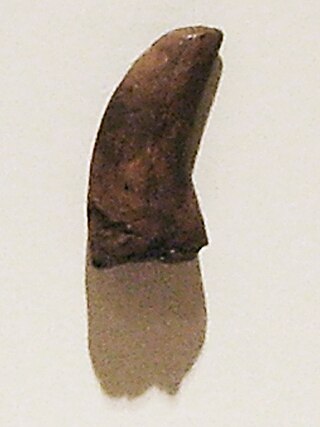
Dromaeosauroides is a genus of dromaeosaurid theropod dinosaur from the Early Cretaceous of what is now Denmark and possibly also England. It was discovered in the Jydegaard Formation in the Robbedale valley, on the island of Bornholm in the Baltic Sea. This is the only likely place for dinosaur remains to be discovered on Danish territory, since the Mesozoic deposits exposed in the rest of the country are marine. Dromaeosauroides is the first known dinosaur from Denmark, and the only one which has been scientifically named. It is one of the oldest known dromaeosaurs in the world, and the first known uncontested dromaeosaur from the Early Cretaceous of Europe.
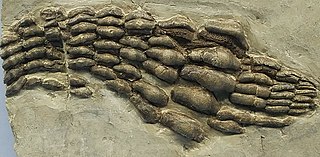
Acrodus is an extinct genus of hybodont spanning from the Early Triassic to the Late Jurassic. It was durophagous, with blunt, broad teeth designed for crushing and grinding. Some Middle Triassic species have been suggested to have grown to lengths of 1.8–2.5 metres (5.9–8.2 ft). Species are known from both marine and freshwater environments, with all Middle and Late Jurassic species only known from freshwater.

Dryolestida is an extinct order of mammals, known from the Jurassic and Cretaceous. They are considered basal members of the clade Cladotheria, close to the ancestry of therian mammals. It is also believed that they developed a fully mammalian jaw and also had the three middle ear bones. Most members of the group, as with most Mesozoic mammals, are only known from fragmentary tooth and jaw remains.

Nannopterygius is an extinct genus of ophthalmosaurid ichthyosaur that lived during the Middle Jurassic to the Early Cretaceous. Fossils are known from England, Kazakhstan, Russia, and Norway and six species are currently assigned to the genus.

Mawsonia is an extinct genus of prehistoric coelacanth fish. It is amongst the largest of all coelacanths, with one quadrate specimen possibly belonging to an individual measuring 5.3 metres in length. It lived in freshwater and brackish environments from the late Jurassic to the mid-Cretaceous of South America, eastern North America, and Africa. Mawsonia was first described by British paleontologist Arthur Smith Woodward in 1907.

The Albanerpetontidae are an extinct family of small amphibians, native to the Northern Hemisphere during the Mesozoic and Cenozoic. The only members of the order Allocaudata, they are thought to be allied with living amphibians belonging to Lissamphibia. Despite a superficially salamander-like bodyform, their anatomy is strongly divergent from modern amphibians in numerous aspects. The fossil record of albanerpetontids spans over 160 million years from the Middle Jurassic to the beginning of the Pleistocene, about 2.13–2 million years ago.
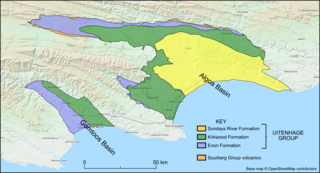
The Kirkwood Formation is a geological formation found in the Eastern and Western Cape provinces in South Africa. It is one of the four formations found within the Uitenhage Group of the Algoa Basin – its type locality – and in the neighbouring Gamtoos Basin. Outcrops of the Kirkwood are also found along the Worcester-Pletmos, Herbertsdale-Riversdale, Heidelberg-Mossel Bay, and Oudtshoorn-Gamtoos basin lines. At these basins the Kirkwood Formation underlies the Buffelskloof Formation and not the Sundays River Formation.
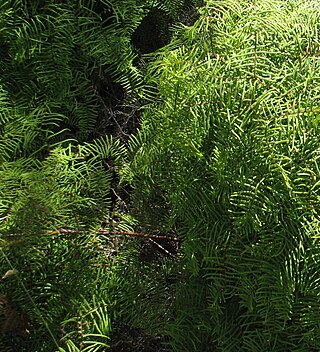
Gleichenia is a genus of ferns. Its closest relative is the genus Stromatopteris, restricted to New Caledonia.
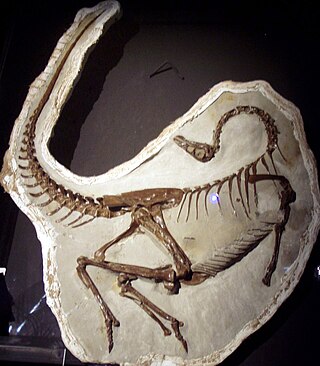
This timeline of ornithomimosaur research is a chronological listing of events in the history of paleontology focused on the ornithomimosaurs, a group of bird-like theropods popularly known as the ostrich dinosaurs. Although fragmentary, probable, ornithomimosaur fossils had been described as far back as the 1860s, the first ornithomimosaur to be recognized as belonging to a new family distinct from other theropods was Ornithomimus velox, described by Othniel Charles Marsh in 1890. Thus the ornithomimid ornithomimosaurs were one of the first major Mesozoic theropod groups to be recognized in the fossil record. The description of a second ornithomimosaur genus did not happen until nearly 30 years later, when Henry Fairfield Osborn described Struthiomimus in 1917. Later in the 20th century, significant ornithomimosaur discoveries began occurring in Asia. The first was a bonebed of "Ornithomimus" asiaticus found at Iren Debasu. More Asian discoveries took place even later in the 20th century, including the disembodied arms of Deinocheirus mirificus and the new genus Gallimimus bullatus. The formal naming of the Ornithomimosauria itself was performed by Rinchen Barsbold in 1976.

Corystosperms are a group of extinct seed plants belonging to the family Corystospermaceae assigned to the order Corystospermales or Umkomasiales. They were first described based on fossils collected by Hamshaw Thomas from the Burnera Waterfall locality near the Umkomaas River of South Africa. Corystosperms are typified by a group of plants that bore forked Dicroidium leaves, Umkomasia cupulate ovulate structures and Pteruchus pollen organs, which grew as trees that were widespread over Gondwana during the Middle and Late Triassic. Other fossil Mesozoic seed plants with similar leaf and/or reproductive structures have also sometimes been included within the "corystosperm" concept sensu lato, such as the "doyleoids" from the Early Cretaceous of North America and Asia. A potential corystosperm sensu lato, the leaf genus Komlopteris, is known from the Eocene of Tasmania, around 53-50 million years old, over 10 million years after the Cretaceous–Paleogene extinction event.

The Uitenhage Group is one of three geological groups, which comprise the onshore and offshore post-Karoo middle to lower Upper Mesozoic geological rock units in South Africa. Stratigraphically, the Uitenhage Group overlies the Suurberg Group and is overlain by the Algoa Group. It contains four formations that range in age from late Early Jurassic and late Early Cretaceous in age.
This article records new taxa of fossil plants that are scheduled to be described during the year 2019, as well as other significant discoveries and events related to paleobotany that are scheduled to occur in the year 2019.
This article records new taxa of fossil plants that are scheduled to be described during the year 2020, as well as other significant discoveries and events related to paleobotany that are scheduled to occur in the year 2020.

Coniopteris is an extinct genus of Mesozoic fern leaves. It was widespread over both hemispheres during the Jurassic and Early Cretaceous, with over 130 species having been described. While traditionally assumed to have been a member of Dicksoniaceae or a close relative of Thyrsopteris, a 2020 cladistic analysis found it to be a stem group of Polypodiales. Most species of Coniopteris probably had a herbaceous habit. Coniopteris laciniata had tufts of leaves sprouting from intervals of a thin, creeping rhizome. The genus is technically a junior synonym of the little used Polystichites, but was conserved by the ICZN in 2013. Some authors suggest a range of Early Jurassic-early Late Cretaceous for the genus, while others suggest a more expansive range spanning from the Middle Triassic to the Eocene.
This paleobotany list records new fossil plant taxa that were to be described during the year 2012, as well as notes other significant paleobotany discoveries and events which occurred during 2012.
This paleobotany list records new fossil plant taxa that were to be described during the year 2023, as well as notes other significant paleobotany discoveries and events which occurred during 2023.














